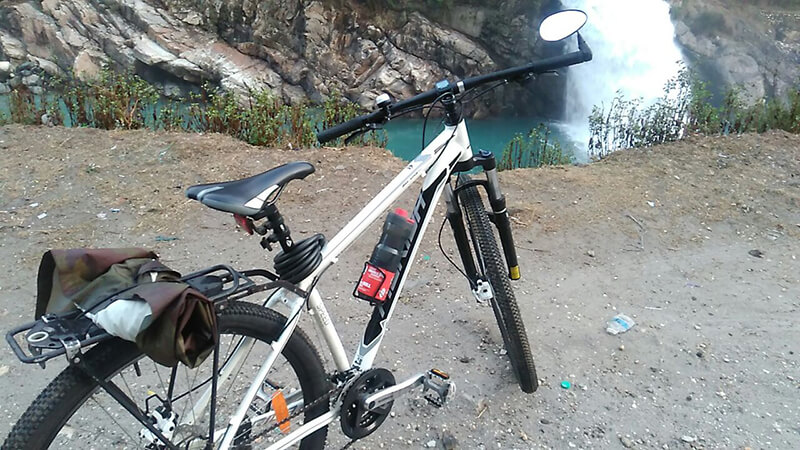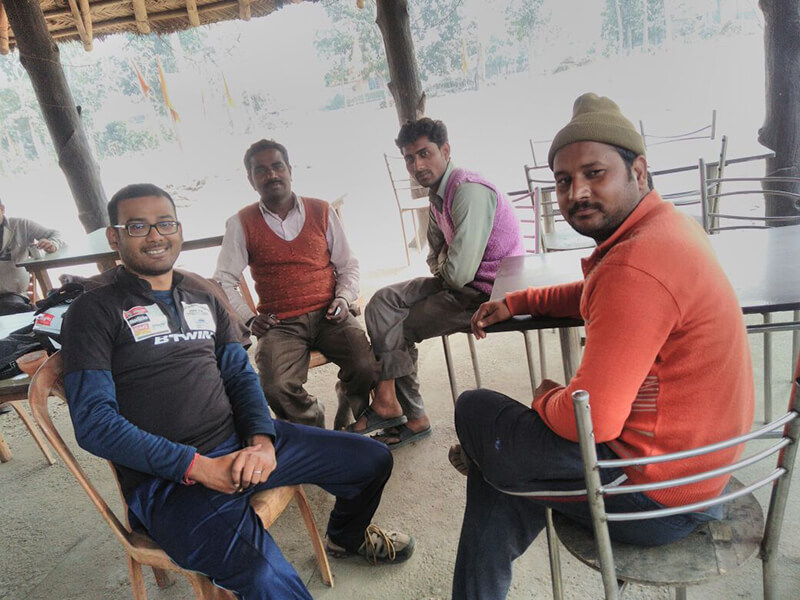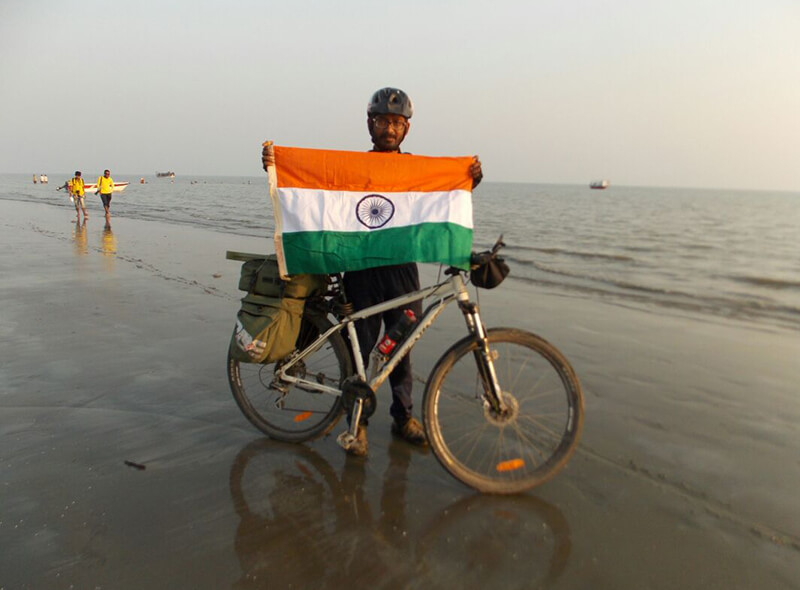Save Ganga and Protect Women
A mountaineer, traveller, trekker from Bengal, Samrat Moulik had decided to create awareness about saving Ganges from pollution through a solo cycling event from sky to ocean. He named the campaign, "Save Ganga and Protect Women". When asked about the motivation behind this noble initiative, Samrat replied, "I love the nature around me and respect Ganges as my mother, I can't even think of harming it but nowadays the unsound situation of Ganges has made me take this kind of initiative. I wanted to know the main causes of pollution in Ganges, the impact of this pollution on humans who are dependent on this river."
He started from Gangotri and covered 5 states of India Uttarakhand, Uttar Pradesh, Bihar, Jharkhand and West Bengal. From West Bengal where the "Padma" river (name of Ganges in Bangladesh) enters Bangladesh, he covered Nawabganj, Rajshahi, Kushtia, Faridpur, Barisal and finally ended his journey at Kuakata in Bangladesh. His journey started on 8th February 2018 and ended on 21st March 2018. He almost covered 3000km by cycling. In these 38 days he tried to capture the picture of the local areas on the sides of Ganges. The main motive of this program was human settlement. This initiative of him has left a great impact on the local people.
He started from "Gangotri Mandir". The temple was not open at that time but he had arranged for some special permits. From Gangotri to Harsil, Harsil to Uttarkashi, Uttarkashi to Tehri, Tehri to Haridwar, Haridwar to Lakhtoi, finally he entered Uttar Pradesh.

After coming back from his journey he shared some of his realizations and experience about this whole journey. When asked about his experience about the condition of Ganges in India as well as in Bangladesh, he said, "In Uttarakhand Ganges is in good condition, but after crossing Haridwar when I reached Nagina (a town in Uttar Pradesh), pollution of Ganges had started. In Moradabad there is cremation centre at Ganga Ghat and this picture is very much common along Ganges route.
The progress and results of the "Ganga Action Plan" was not visible to me along my whole journey. The tributary rivers are also polluting Ganges with their dumps. In Kanpur the condition of Ganges is alarming. For some project the path of Ganges has been blocked. Though I noticed one good thing, the Government has stopped or shifted the tanneries near Ganges to keep the pollution low from the toxic wastes of these industries.

In Allahabad, if not for Yamuna, Ganges would have become nothing but a thin streamline. Then when I entered Bihar I collected a lot of data of 100% pollution of Ganges. Out of this 100%, 98% is industrial wastage, 1% plastic and last 1% is for humans. The 1% pollution for plastics can be cured through proper Government measures and the pollution caused by humans can be filtered by the river itself. But the problem is the wastage of the industries. In Patna, in the past the dead body of the animals were thrown into the river but now after a lot of efforts cremation centre for animals has been established. But the waste management for medical wastages has not been done yet.
In Jharkhand, Ganges has regained it's old beauty and is in good condition with the help of the tributaries like Gomti, Punpun etc. Near Rajmahal the Ganges has bifurcated into Hooghly river, which enters West Bengal and the Padma, which enters Bangladesh.

Padma is also not in a very good condition, quantity of sand is increasing, but in comparison to India the condition of river is way better, water level is higher and water is more pollutant free. The dependency of common people on river is very high in Bangladesh so they have no other choice but to take care of the river as much as possible. On this note I would like to share that on Padma, Padma Bridge project is going on, but I am afraid that by the time of project completion the river may convert into a stream.
So in a nutshell I can say that the condition of Ganges in India as well as in Bangladesh is not very good. I am afraid that after 40 years Ganges may not have the same presence and essence in India."
Samrat also shared the road map of his 38 days journey.
12th & 13th February 2018 - Gangotri to Uttarkashi
14th & 15th February 2018 - Uttarkashi to Chamba
16th February 2018 - Chamba to Haridwar
17th February 2018 - Haridwar, Najibabad to Nagina
18th February 2018 - Nagina to Moradabad
19th February 2018 - Moradabad to Bareilly
20th February 2018 - Bareilly to Katra
21st February 2018 - Katra to Farrukhabad
22nd & 23rd February 2018 - Farrukhabad to Kannauj
24th February 2018 - Kannauj to Kanpur
25th February 2018 - Kanpur to Fatehpur
26th - 28th February 2018 - Fatehpur to Allahabad
1st & 2nd March 2018 - Allahabad to Varanasi
3rd March 2018 - Varanasi to Buxar
4th March 2018 - Buxar to Ara
5th & 6th March 2018 - Ara to Patna
7th March 2018 - Patna to Mokama
8th March 2018 - Mokama to Lakhisarai
9th March 2018 - Lakhisarai to Bhagalpur
10th & 11th March 2018 - Bhagalpur to Sahibganj
12th March 2018 - Sahibganj to Gazole
13th March 2018 - Gazole to Hili
14th March 2018 - Hili to Naogaon
15th March 2018 - Naogaon to Rajshahi
16th March 2018 - Rajshahi to Ishwardi
17th & 18th March 2018 - Ishwardi to Faridpur
19th March 2018 - Faridpur to Barisal
20th March 2018 - Barisal to Barguna
21st March 2018 - Barguna to Kuakata Sea Beach
The name of the initiative was "Save Ganga and Protect Women", so gradually the question arises that how he tried to convey this message. On this Samrat informed us, "Though the initiative has this kind of name, this doesn't mean that I have to arrange meets or give speeches among the crowd. The main target was to get a picture of the current situation of Ganges in a very brief time, it's impact on our life in present scenario and the impact of our lifestyle on it. I have interacted with a lot of people personally and got to know the condition of the river more clearly and tried to convey my message to them as much as possible. In interior parts of India as well as in Bangladesh I couldn't get to interact a lot with women or click any pictures of them or their situation, as it is strictly prohibited in those parts.
Samrat adopted the approach of a common man and not as a hero on cycle to reach out to the masses and spread awareness about pollution of Ganges. He feels that he has succeeded to a great extent in spreading awareness among the masses, but from the "Protect Women" perspective he could not achieve much success. "The main reason behind this is, still in a lot of places in India people think that women are incompetent to build a nation, they are inferior to men. They are inferior in terms of social responsibilities," Samrat feels. Throughout the course of his journey Samrat interacted informally with the people and developed a great camaraderie with them. They in return assisted him with food, water and other essential utilities.
Samrat had an overwhelming experience in Bangladesh. His ancestral home was in Shariatpur in Bangladesh formerly known as Faridpur. He received a very warm welcome in Bangladesh with everyone playing the perfect host. "I am proud to be a Bengali and would love to visit Bangladesh again and again." told by Samrat while sharing his experience in Bangladesh during his journey.
Photo Courtesy: Samrat Moulik






